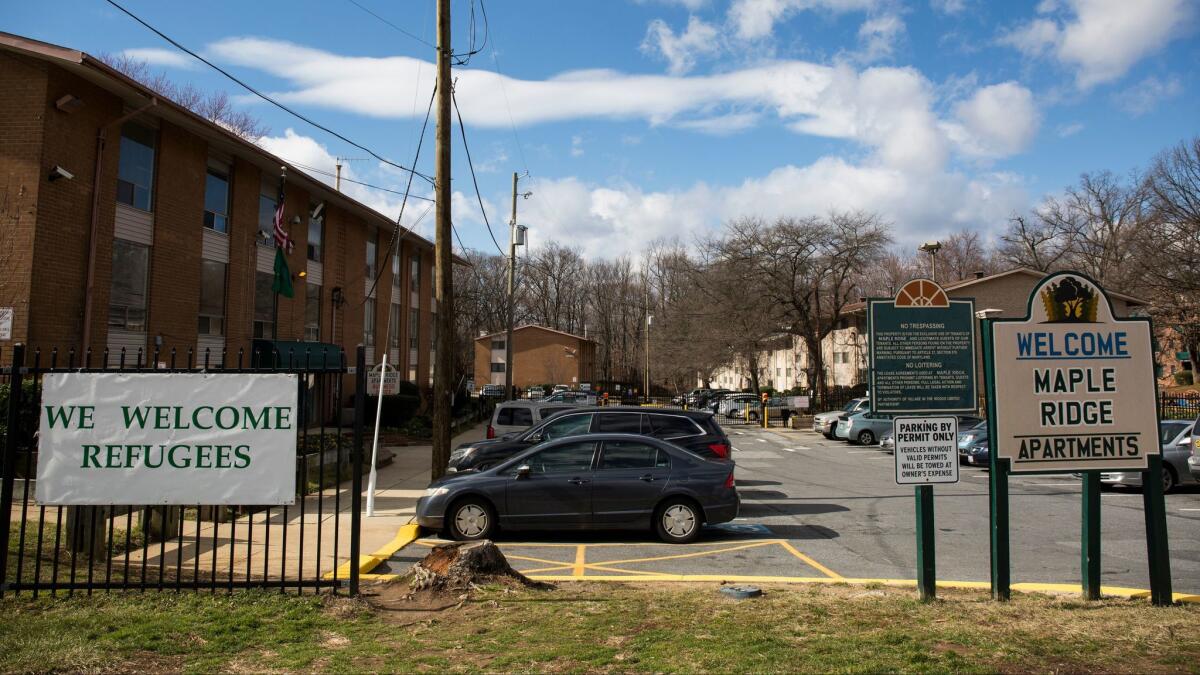Opinion: Trump’s limits on refugee resettlement are cruel and counterproductive

- Share via
In yet another set of draconian policy decisions by the Trump administration, the U.S. will accept no more than 18,000 refugees this coming year and, by adopting a new formula, will significantly reduce admissions for people fleeing persecution for reasons other than religion.
Count this as a win for the immigration hard-liners and a loss for the nation.
At the same time, the government announced that it will allow state and local jurisdictions to refuse to accept refugees for resettlement through the nonprofit organizations the government relies on for help. That’s an atrocious policy that will let local xenophobic politicians shut the door to people who the federal government says do not pose a risk to public safety.
This is a significant and astonishing abdication of federal responsibility. After the 2015 Islamic State-connected terrorist attacks that killed 130 people in Paris, 31 governors, all but one of them Republicans, vowed they would not accept Syrian refugees. A toothless pledge then, but this policy now gives those politicians veto power over the federal government.
If there’s any consolation here it’s that once refugees get resettled, there are no limits on where they can move, which means the new policy primarily serves as yet another “you’re not welcome” sign.
The administration also grossly exaggerated how much sanctuary it will be offering to the persecuted, saying it “expects to receive more than 368,000 new refugees and asylum claims” in the fiscal year that starts Oct. 1. But rather than reflecting the country’s “generous record of providing humanitarian protections,” as the administration claims, the big number hides the severely reduced amount of refugee admissions by combining that figure with the more than 350,000 asylum claims expected to be filed. Asylum requests often fail, which means the U.S. will be admitting far, far fewer than 368,000 people in need of a safe home.
Briefly, federal law allows people from other countries, once they reach the U.S., to ask for asylum on grounds that they face persecution based on their “race, religion, nationality, membership in a particular social group, or political opinion.” Those applications are processed through immigration courts and can take years.
Refugees meeting the same criteria apply from outside the U.S., usually through the United Nations High Commissioner for Refugees and U.S. consulates. They are vetted by both the UNHCR and the U.S. government while still overseas and, once granted resettlement, they arrive here legally to begin their new lives with no impact on the immigration courts.
Notably, Congress has not authorized any caps on the number of people to whom the U.S. grants asylum. But the 1980 Refugee Act requires the government, in consultation with Congress, to set an annual ceiling for refugee admissions. In the last year of the Obama administration, it was 110,000 refugees. For the current year, the Trump administration set the overall cap at 30,000 with regional limits of 11,000 from Africa, 4,000 from East Asia, 3,000 from Europe and Central Asia, 3,000 from Latin America and the Caribbean, and 9,000 from the Near East and South Asia.
The new formula reserves slots for 4,000 Iraqis endangered because they helped the U.S. military during the war; 5,000 people globally claiming religious persecution; and 1,500 people from Guatemala, Honduras and El Salvador, a sop intended as part of efforts to stem the flow of tens of thousands of migrants from the Northern Triangle countries. The remaining 7,500 refugee slots are for persecuted people seeking family reunification.
Also, the notion that somehow the government can’t process both refugees and asylum requests is absurd. As Human Rights First argued a couple of years ago, “the protection offered by the United States is not a zero-sum game; one program need not come at the expense of the other. Rather than rob resources from the Refugee Corps, the Trump administration should properly fund and staff both the Refugee Corps and the Asylum Division, including by hiring officers capable of addressing the backlog for which funds are already allocated.”
In fact, many of the problems with the immigration system, including backlogs in the immigration courts and visa processing, could be improved by increasing the capacity — read, hiring more people — to handle the work that needs to be done.
But when the government’s overall objective is to limit all forms of immigration, an overwhelmed system offers yet another bureaucratic hurdle for people trying to gain legal permission to live here.
More to Read
A cure for the common opinion
Get thought-provoking perspectives with our weekly newsletter.
You may occasionally receive promotional content from the Los Angeles Times.











